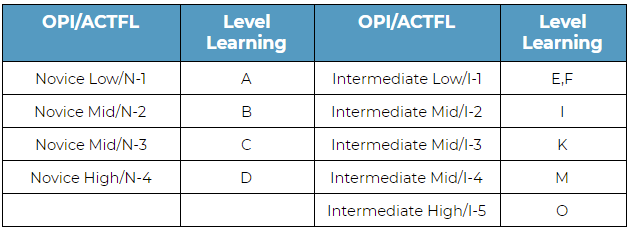Standards Mapping and Benchmarks
标准对照表和水平参考基准
- Standards Mapping 标准对照表
- Benchmarks 水平参考基准
Based on well researched language frameworks, the Level Learning team developed a set of systematic and demonstrable interpersonal oral, reading and writing levels and standards.
在针对各类语言框架进行了充分的研究后,Level Learning团队自主研发了一套系统化的语言分级标准,内容覆盖
日常交际口语、阅读和写作。

- ACTFL
- Common Core
- Chinese National Curriculum 中国语文课程标准
ACTFL Proficiency Level Mapping to Level Learning
等级对照图
Chinese Reading 中文阅读

Chinese Writing 中文写作

Chinese Interpersonal Oral 中文日常交际口语

Level Learning’s levels and standards were developed based on the Common Core ELA Anchor Standards. The diagram below shows the relationship between Common Core Anchor Standards and Level Learning reading and writing standards.
Level Learning的级别和标准是基于Common Core ELA Anchor Standards而制定的。从下面的图表中可以看出Common Core Anchor Standards和Level Learning阅读及写作标准之间的关系。
Common Core for ELA
Language and Reading Anchor Standards
语言及阅读标准


Common Core for ELA
Writing Anchor Standards
写作标准

Oral Standards
口语标准

中国语文课程标准确定了识字、读、写和说的标准。这些标准通过教授相应年级的课本得以体现。我们详细地分析了中国语文课程标准,发现这些标准与美国共同核心标准阅读的框架有共通之处。由于Level Learning标准是基于美国共同核心标准框架,因此可以说Level Learning标准与中国语文课程标准有共通之处。点击下载详细内容。
Chinese National Curriculum (中国语文课程标准) identifies standards for character recognition, reading, writing and speaking. These standards are expected to be instructed along with the textbooks designated for each grade. We unpacked the reading standards and found that they correlate with the Common Core Reading Framework. Since Level Learning standards are designed based on Common Core Framework, Level Learning’s standards also correlate with Chinese National Curriculum (中国语文课程标准). Download detailed guide here.




我们根据Level Learning的文本分级标准,以部编版语文课本作为参考,为一到九年级的大部分课文进行了分级。下面的表格展示了每册课本主要覆盖的等级分布。这些等级可以和各年级的目标等级相互参照,并且得到了北京某所知名双语学校的验证。这些年级的目标等级设置是根据Level Learning评估系统多年来累积的测试数据分析得出的。因为中国语文课程标准和Level Learning标准都是基于类似的框架,所以教师可以参考和结合Level Learning的相应等级来指导和准备语文课本的教学。同时,教师还可以从Level Learning的测试系统中获得数据,从而进一步指导学生的学习。
Using Level Learning Text Complexity Standards, we identified the level of most texts in the G1-9 textbooks using 部编版语文课本 as a reference. The table below shows the key range of text levels in each textbook. These levels were further cross-referenced with the grade level performance targets and validated by a leading bilingual school in Beijing, China. The grade level performance targets were set based on multiple years of collected student data using the Level Learning assessments. Given CNC and Level Learning standards are based on similar framework, teachers can plan instruction of a text in the textbook using standards in the matching level within Level Learning. In addition, teachers can obtain data on student learning based on assessment results in Level Learning system.

The number of language programs who have adopted our Chinese reading platform has grown tremendously. With the large data set, we can now offer benchmarks for the following types of programs in different parts of the world.
- Mandarin Dual Language Immersion (DLI) in the United States
- Language programs across Asia
- World Language programs offered at International Schools
- Bilingual programs in Mainland China
使用Level Learning中文阅读平台的学校数量正在大幅增长中。在收集和整理了大量的数据之后,我们现在可以为以下几类语言项目提供水平参考基准:
- 美国中文双语浸入式课程
- 亚洲学校中文语言课程
- 亚洲国际学校世界语言课程
- 中国大陆双语课程
- US Mandarin DLI 美国中文双语浸入式课程
- Language Programs across Asia 亚洲学校中文语言课程
Level Learning now serves over two-thirds of all the Mandarin DLI programs across the United States. Most of the DLI programs have been implementing Level Learning for multiple years and the quality of implementation has continue to improve. Based on the data collected, these are the end of year reading level benchmarks.

We were able to collect student home language data from approximately two-thirds of the students involved in the above benchmark study.
0%-25% students with home language as Chinese

26% to 50% students with home language as Chinese

51% or more students with home language as Chinese

Level Learning serves different types of learners and context
- International Schools across Asia serving a wide range of learners
- Native : Students who are native Chinese speakers
- Mixed Language Exposure : Non-native speakers who have 3 or more years of language learning or experience outside of the classroom
- CAL : Non-native speakers who are learning Chinese as an additional language with under 2 years of language learning experience
- Bilingual Schools in Mainland China
- Majority Native Chinese Students
- Utilize Chinese National Curriculum and Text Books
Level Learning服务于不同类型和语言环境下的学生:
- 亚洲的国际学校为广泛的学习者提供服务 亚洲的国际学校
- 母语:母语学生
- 二语学生(中文学习经验在3年及以上,或者在课堂之外有中文背景/语言环境的学生,例如父母中的一方母语是中文等)
- 二语学生(中文学习经验为0-2年)
- 中国大陆的双语学校
- 大部分学生为中文母语学生
- 使用中国国家课程教材使用中国语文课程标准和部编版语文课本
International Schools across Asia : Chinese Reading
亚洲的国际学校 : 中文阅读
Data collected July, 2023

Bilingual Schools in Mainland China : Chinese Reading
中国大陆的双语学校 : 中文阅读
Data collected July, 2023
Using Level Chinese Text Complexity Standards, we identified the level of most texts in the G1-9 textbooks using 部编版语文课本 as a reference. The table below shows the key range of text levels in each textbook. These levels were further cross-referenced with the grade level performance targets and validated by a leading bilingual school in Beijing, China. The grade level performance targets were set based on multiple years of collected student data using the Level Chinese assessments. Given CNC and Level Chinese standards are based on similar framework, teachers can plan instruction of a text in the textbook using standards in the matching level within Level Chinese. In addition, teachers can obtain data on student learning based on assessment results in Level Chinese system.
我们根据Level Chinese 的文本分级标准,以部编版语文课本作为参考,为一到九年级的大部分课文进行了分级。下面的表格展示了每册课本主要覆盖的等级分布。这些等级可以和各年级的目标等级相互参照,并且得到了北京某所知名双语学校的验证。这些年级的目标等级设置是根据Level Chinese评估系统多年来累积的测试数据分析得出的。因为中国语文课程标准和Level Chinese标准都是基于类似的框架,所以教师可以参考和结合Level Chinese的相应等级来指导和准备语文课本的教学。同时,教师还可以从Level Chinese的测试系统中获得数据,从而进一步指导学生的学习。

